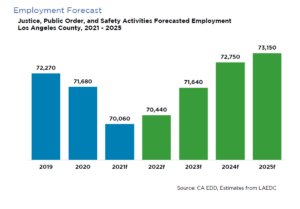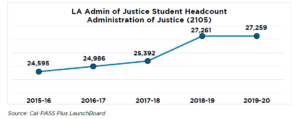The Center for a Competitive Workforce (CCW) hosted a virtual Regional Program Advisory Meeting on the Administration of Justice workforce needs on Friday, November 19, 2021, in partnership with the Los Angeles County Economic Development Corporation (LAEDC).
KEY DATA POINTS PRESENTED BY THE INSTITUTE OF APPLIED ECONOMICS, LAEDC
- Focusing on justice, public order, and safety activities, there were roughly 71,680 jobs in Los Angeles County as of 2020. This includes police and fire protection, courts, correctional institutions, in addition to more.
- The number of employees in this industry has fallen a bit over the past decade and is down from nearly 75,000 in 2010. But there was a smaller drop due to the pandemic than many other industries in the County.

- The average annual wage was extremely high, reaching over $123,000 in 2020 compared to 2010, where the annual wage was $104,664.
- There has not been a drop in employment due to the pandemic. The 2021 employment level is forecasted to be only 2,000 jobs below the 2019 pre-pandemic baseline.
- If we look ahead, there will be resumed growth in the next four years as the recovery process continues in Los Angeles County. By 2024 employment is expected to be back above the pre-pandemic level, and there will be 3,000 jobs added between now and 2025.
- The workforce’s characteristics in the industry are seen as follows:
- Workers tend to be slightly older and have greater educational attainment than the overall workforce of the County.
- 3.5% of justice, public order, and safety activities workers are under 24 years old, while nearly 54% are above 45 years old.
- 64% of employees have at least some college experience, with 31% holding a bachelor’s or higher.
- There is a much higher proportion of black workers in this industry than the County – 17% of the workforce – and there’s a much lower proportion of white workers – 22% compared to 31% of the total County workforce.
KEY COMMUNITY COLLEGE TALENT SUPPLY DATA POINTS PRESENTED BY CENTER OF EXCELLENCE (COE)
- On the supply side (educational side), there are several primary programs training students for careers in administration of justice:
- Administration of Justice
- Corrections (2105.10)
- Probation asnd Parole
- Industrial and Transportation Security
- Forensics, Evidence, and Investigation
- Police Academy
- Combined, there were nearly 27,300 students enrolled in administration of justice programs during the 2019-20 academic year at LA community colleges. Student enrollment in these programs has consistently increased over the previous five academic years.

- Administration of justice programs is the third-largest enrolled program behind child development programs and accounting programs.
- Between 2017 and 2020, community colleges in the region conferred an average of 2,863 awards in administration of justice programs.
- Variety of awards offered at all 19 of the region’s community colleges, with East Los Angeles having the highest student headcount for awards given.
- Student Demographics are as follows:
- Compared to all CE programs in LA County, administration of justice programs have a slightly more significant portion of males (55%) than females (44%).
- In terms of race and ethnicity, a slightly larger number of Hispanic students (58%) compared to all CE programs (54%), as well as a smaller number of White (11%) and Asian (3%).
- Admin of Justice enrolls more older students than all CE programs.
Click here to see the Administration of Justice Regional Program Advisory Los Angeles Community College Look Book for a full data set.
Industry Representation
- Bella Smith, Manager of Client Relations and Recruitment at Lifeline Ambulance
- Clarissa J. Torres, Deputy Officer, Recruitment Unit at County of Los Angeles Sheriff’s Department
- Joseph “Joe” Paul, Managing Director at Los Angeles Regional Reentry Partnership
- Joseph Quire, Lieutenant, Training Bureau at County of Los Angeles Sheriff’s Department
- Katherine Falcon, Probation Director at County of Los Angeles Probation Department
- Leanne Steinhaus, Examinations and Recruitment Unit, Human Resources Division at Los Angeles County Probation Department
- Louis Lavender, Detective, Los Angeles Police Department and Adjunct Professor at Los Angeles Southwest College
- Marilyn U. Urbina, Examinations and Recruitment Unit, Human Resources Division at Los Angeles County Probation Department
- Captain Mario Patrick, Commanding Officer at Los Angeles Airport Police
- Randy Allen, Deputy Chief at Port of Los Angeles Police
- Tommie Baines, Probation Director at County of Los Angeles Probation Department
- Victoria A. Ortiz, County of Los Angeles Sheriff’s Department
EMPLOYER PERSPECTIVES
What trends are you and your industry experiencing overall and specifically with COVID-19 this year?
- We did not have a hiring slowdown after COVID. We knew in the medical industry that EMS is needed. Because of the many medical professionals becoming infected with COVID and having to quarantine, many would not choose to come back just because they weren’t sure if they wanted to risk that again. Many of them had family members that were immunocompromised and were worried.
- Our [probation] deputies were not prepared to work in what would have been considered a biohazard environment. Like the other agencies, we were not prepared on the appropriate methods of working in the juvenile halls while maintaining a 6-feet distance, wearing masks, and other protocols. Especially when it comes to emergencies, it’s not easy to always adhere to the requirements, which was a struggle.
- Apart from COVID, law enforcement has been targeted in such a derogatory way that it has given the community different opinions regarding the administration of justice profession as a field, even more so after what happened to George Floyd. It is important for the region’s community colleges, which are gateways into higher education, to understand better that they can be part of the solution and change regardless of what happens.
What workforce trends do you see that our community colleges should be aware of in order to prepare a more competitive workforce?
- Suppose we evolve with what we have experienced with how quickly things can go bad. In that case, we should think about creating a full economy where everyone is involved versus creating continued barriers that limit people from accessing potential job opportunities, referencing those with a criminal history. Using the fair chance hiring, we could qualify the crime against the actual occupation and all the different elements that go into a person performing at a high level for those jobs as we move into this next era of our evolution and putting our society back into the vibrant place in terms of our economic impact and just full inclusion of people participating.
- If community colleges are going to pull together or add to the curriculum, it should be around a class that talks about the history of law enforcement and understanding the roles that law enforcement played throughout history. They were utilized inappropriately by unjust laws and all kinds of issues that law enforcement did not choose to be a part of; they just got thrown into and became the face of some of those situations that we see now.
How would you describe the future of the field in terms of evolving workforce needs?
- We are at an all-time high for the need. We are always hiring and hiring as many EMTs as we can. We saw a significant drop during COVID because people did not want to risk their lives and the mandate to have to be vaccinated. Our need doesn’t stop, and we are proactively recruiting from colleges and reaching out to partners.
- We need people with emotional intelligence, who understand what is happening in real time, skills in reading the room, reading the individuals, and responding appropriately in that kind of environment.
- We get many candidates to sign up and take the test every month but are struggling in the diversity part. Getting women to sign up has been the most challenging part for us. We’ve tried to reach all different demographics by going to different events, reaching out to the community and reaching out to our local colleges.
For full comment, click here to see the Administration of Justice Regional Program Advisory Los Angeles Community College Program Notes. To view the Administration of Justice Look Book, click here. For questions, please contact Isabel Duran, Isabel.duran@laedc.org
The Center for a Competitive Workforce is funded by the California Community Colleges Chancellor’s Office under the Strong Workforce Program (SWP) as a Los Angeles Regional Project.


